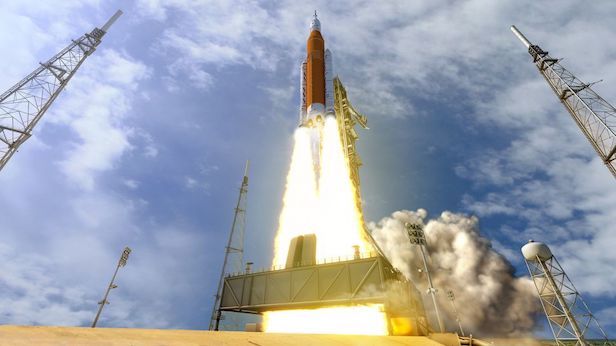NASA’s first SLS megarocket launch to the Moon could be delayed to 2021
The Space Launch System megarocket will eventually take humans back to the Moon in 2024

Artist’s illustration of NASA’s Space Launch System megarocket launching the Orion crew capsule. Image credit: NASA
NASA has yet to set a launch date for the first test flight of its long-delayed Space Launch System (SLS) megarocket, which the agency plans to use to send astronauts to the lunar surface in 2024. And it looks like more delays could be right around the corner.
Although NASA said this summer that its new rocket should finally lift off by the end of 2020, the first mission may slip to the middle of 2021, Ken Bowersox, NASA’s acting associate administrator for human exploration and operations, said in a presentation at the International Symposium for Personal and Commercial Spaceflight (ISPCS) on 10 October 2019.
That mission, known as Artemis 1, will send an uncrewed Orion spacecraft on a trip around the Moon. Following that initial test flight, NASA aims to launch Artemis 2 — the first human mission of NASA’s Artemis program — in 2022. That mission will fly astronauts on a loop around the Moon, but they won’t land there just yet.
In 2024, NASA plans to land the first woman and the next man on the lunar surface for the Artemis 3 mission. And in between these two crewed Artemis missions, NASA plans to use an SLS rocket to launch the robotic Europa Clipper mission to Jupiter’s moon Europa.
NASA is still officially targeting 2020 for the launch of Artemis 1, but this timeline assumes that everything goes according to plan during the testing the agency will be conducting over the next year or so.
“The schedule that we’re managing to is very, very aggressive,” Bowersox said. He added that the SLS core stage will likely be finished by the end of this year, after which it will be shipped over to NASA’s Stennis Space Center for testing, which in the best case scenario should take about five or six months. “But then there’s risks like weather, and then we don’t know how much refurbishment we might need to do to the stage after we’ve run those engines for a whole flight duration and a test flight, so we’re conservatively thinking we could take an extra couple months to do some of that work.”
“In the very best case, we have a chance to actually have a rocket on the pad and launched by the end of next year, but when you start throwing all those different uncertainties, it’s more likely that we will move out into 2021.”
According to Bowersox, NASA will be coming up with a new official launch target after the agency hires a new associate administrator for human exploration and operations; that position was held by Bill Gerstenmaier from 2010 until about three months ago, when he was reassigned as a special advisor to NASA’s Deputy Administrator Jim Morhard. While it’s not clear exactly when NASA will fill Gerstenmaier’s old position, Bowersox said that he expects NASA officials to make a decision within the next few weeks.
Keep up to date with the latest news in All About Space – available every month for just £4.99. Alternatively you can subscribe here for a fraction of the price!




